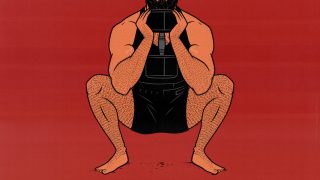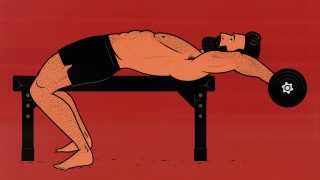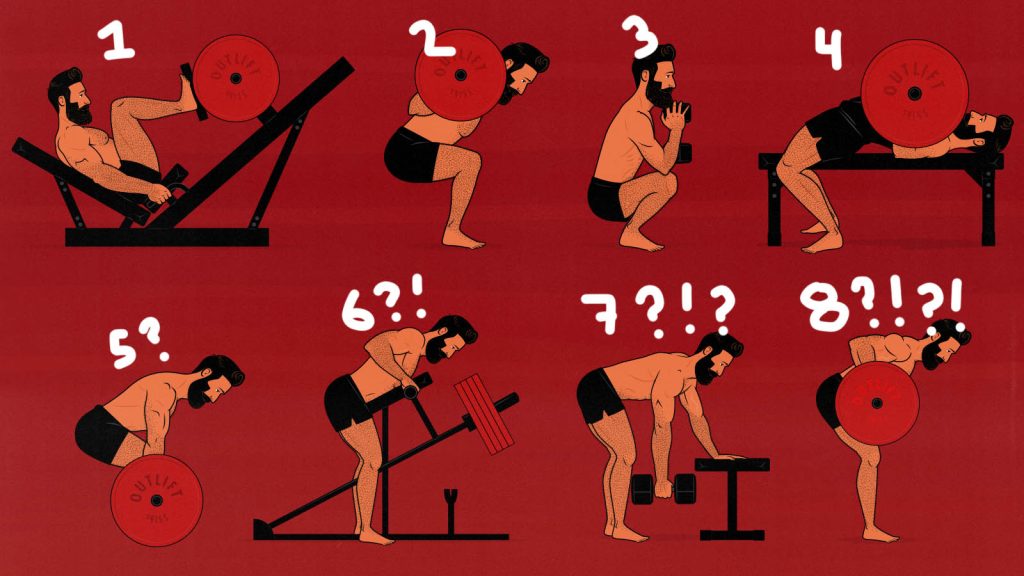
How Many Exercises Should You Do Per Workout?
You should probably do 4–7 exercises per workout, depending on your workout split, experience level, and goals. You need a balanced mix of exercises that target all of the muscles you’re trying to grow, and then you need to split them up over your workouts, ideally training each muscle 2–3 times per week with 10–20 total sets.
- 2–3 full-body workouts: You probably want a squat, hip hinge, press, pull, and a couple of isolation exercises, giving you 4–7 exercises per workout.
- 4-day upper/lower split: The upper-body workout should have at least one pressing and pulling exercise and a couple of isolation exercises, giving you 3–6 exercises per workout.
- 5–6 day splits: You’ve got enough training days that you don’t need very many exercises per workout. Doing 3–5 exercises is plenty.
As a beginner, it helps to do more exercises per workout. You don’t need that many sets per exercise, the weights aren’t heavy enough to be very fatiguing, and you won’t need to rest very long between sets.
If you’re maintaining or cutting, you won’t build much muscle, so you might want to do fewer exercises. You still need to do your compound exercises, but you don’t need as many isolation exercises, and you don’t need as much exercise variety.
If you’re bulking or recomping, you can stimulate more muscle growth by doing more. Instead of doing just one pressing exercise, you might want one exercise for your lower chest, another for your upper chest and shoulders, and then add some triceps extensions.
We’ll go through it step by step, and then I’ll give you some workout routines to try.
What Exercises Do You Need?
You can train all of the muscles in your body with a mix of squats, hip hinges, presses, and pulls:
- Squats: Back squats, goblet squats, split squats, and leg presses.
- Hip Hinges: Deadlifts, back extensions, hip thrusts, and step-ups.
- Presses: Push-ups, bench presses, overhead presses, and dips.
- Pulls: Pull-ups, pulldowns, pullovers, and rows.
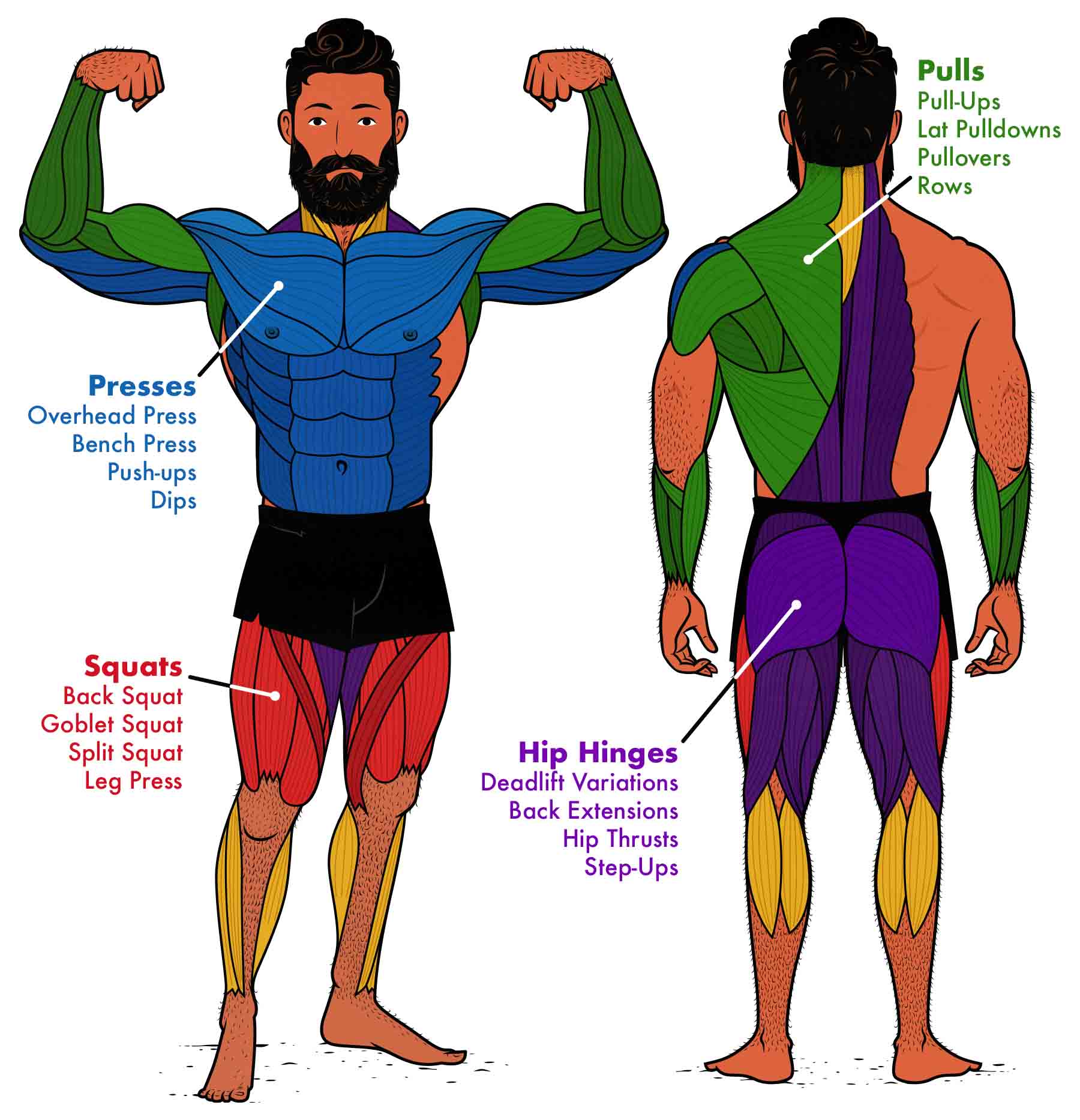
You don’t need to do every exercise for every muscle group, though. Dips are just a more advanced variation of push-ups. If you’re doing Romanian deadlifts, you don’t need hip thrusts or back extensions. Leg presses are just squats that don’t work your postural muscles. There’s nothing wrong with doing both, but it isn’t needed.
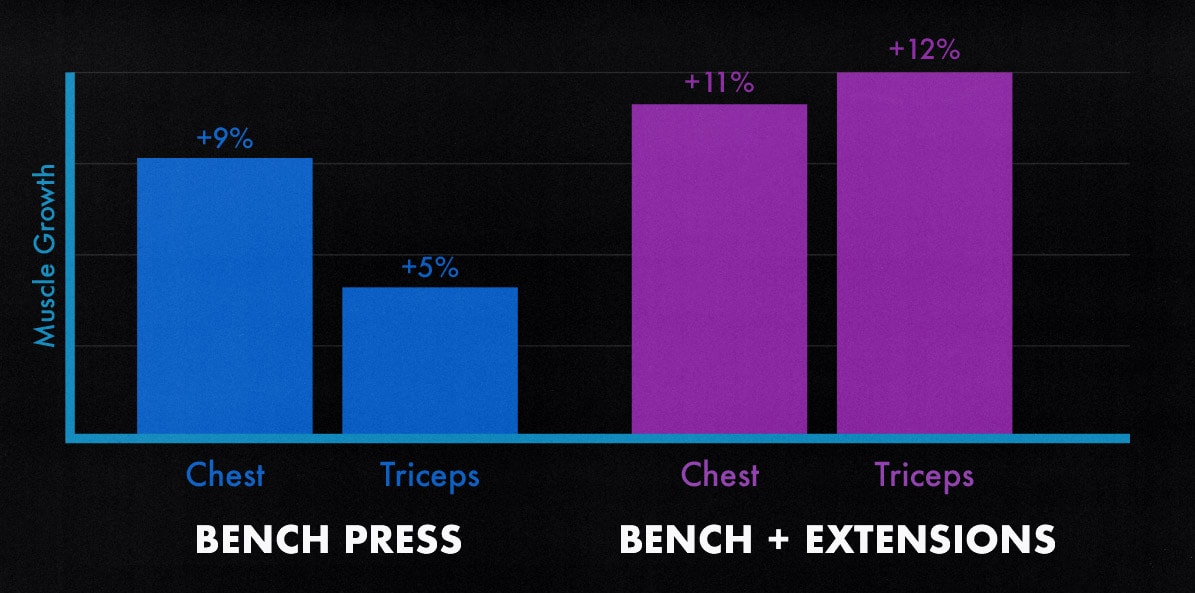
It helps to add isolation exercises for the muscles you’re eager to grow. Presses are better for your chest and front delts than for your triceps and side delts, so it helps to add triceps extensions and lateral raises (study). Similarly, pulling exercises are better for your back muscles than your biceps, so it helps to add biceps curls. You don’t have to, but if those muscles are important to you, it does help.
Even if your workout program already trains a muscle well, you might want to add an extra exercise anyway. Maybe your chest is covered by push-ups and overhead presses, but you really want a bigger upper chest, so you add an incline bench press.
Beginner Workout Splits
As a beginner, I recommend doing a full-body workout routine. If you’re training for general health and you’re happy with slower progress, 2 full-body workouts is enough. If you’re eager to build muscle or transform your physique, you’ll get better results by doing 3. Adding a fourth day probably won’t help.
The advantage of full-body workouts is that you get to do all of the best exercises every workout. That gives you the practice you need to improve your technique, and it stimulates a tremendous amount of overall muscle growth.
A good full-body workout has a squat, hip hinge, pull, and press in almost every workout, giving you as few as 4 exercises per workout. You can add a couple of isolation exercises afterward, bring that up to as many as 7:
| Exercise | Sets | Reps |
|---|---|---|
| Lat Pulldowns | 3–4 sets | 8–12 reps |
| Goblet Squats | 2–4 sets | 6–12 reps |
| Push-Ups | 3–4 sets | AMRAP |
| Romanian Deadlifts | 2–3 sets | 6–12 reps |
| Dumbbell Curls | 2–3 sets | 8–12 reps |
| Overhead Extensions | 2–3 sets | 8–12 reps |
| Lateral Raises | 2–3 sets | 10–15 reps |
This workout looks intimidating, but it takes less than an hour if you use supersets. Bring a dumbbell over to the lat pulldown station so you can do goblet squats while you rest between sets. Do your Romanian deadlifts while you rest between sets of push-ups. When you finish a set of curls, lift the dumbbell overhead for a set of triceps extensions.
If you can make it through a workout like that, and if you can do it 2–3 times per week, then you can build muscle incredibly quickly. This period of rapid growth is called “newbie gains.” In our Bony to Beastly Program, guys normally gain a little over 20 pounds in 5 months, often without gaining a noticeable amount of fat:
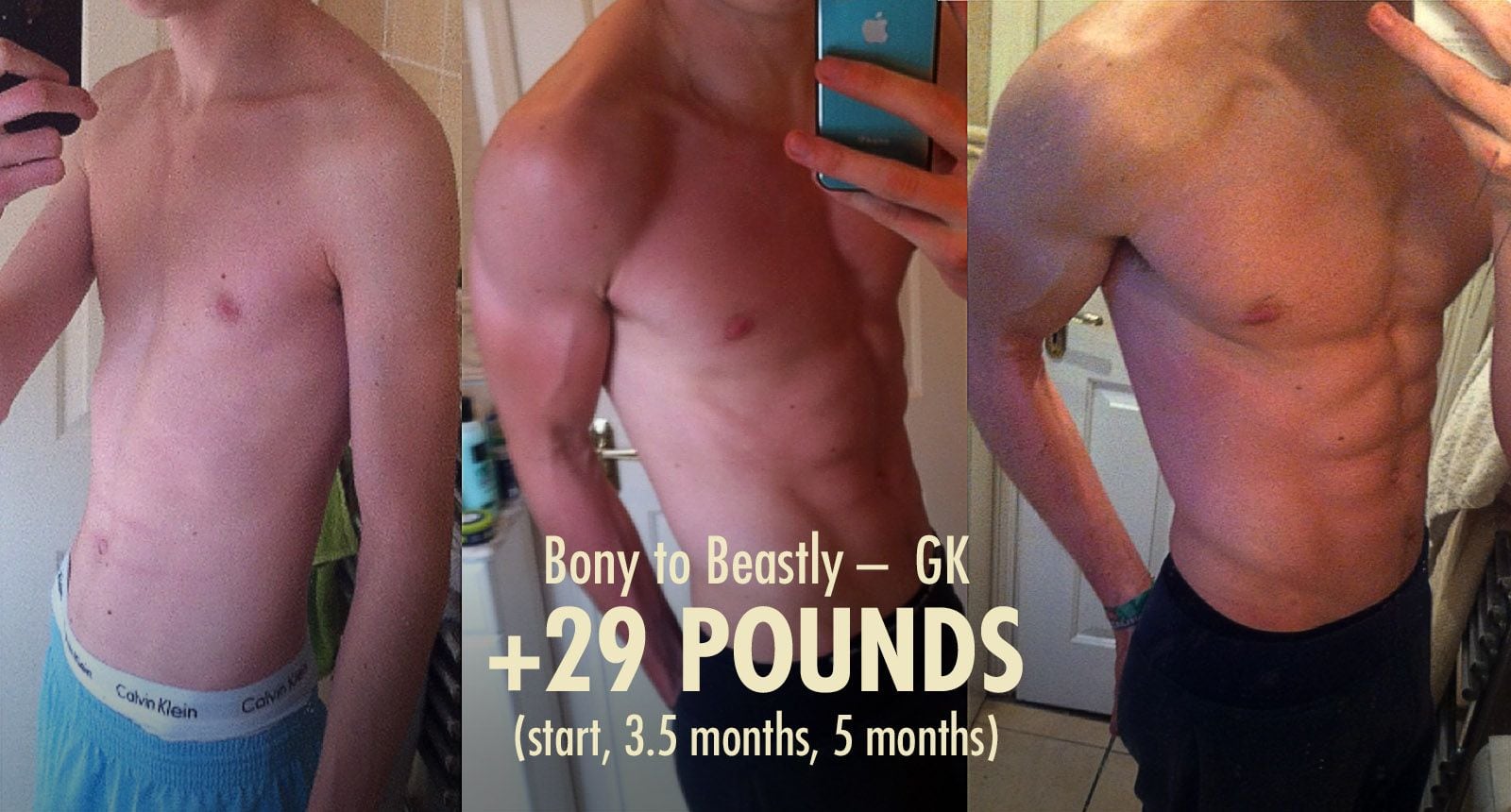
Intermediate Workout Splits
As an intermediate, it helps to train at least 3 times per week, and you might benefit from a fourth or even fifth workout day. You don’t need to practice the big exercises as often, you can benefit from more variety, and the weights get heavier, so it helps to spread the workload over more workout days.
Another option is to stick with 3 workouts but switch over to a specialization routine where you do less work for some muscles, freeing up more energy for others. For example, you could put your lower body on maintenance while shifting more work to your arms, like in our arm specialization program.
When you’re training more than 3 days per week, it usually helps to split your body up into different areas. You could train your upper body one day and your lower body the next. Maybe you have a push day, pull day, and leg day. Maybe you do a Bro Split with a chest day, back day, leg day, shoulder day, and arm day.
When you split your body into different areas, you don’t need to do as many exercises per workout. However, most people use it as an opportunity to do a wider variety of exercises. For example, a chest/push workout might have a bench press, incline bench press, overhead press, triceps extension, and lateral raise, giving you 5 different exercises:
| Exercise | Sets | Reps |
|---|---|---|
| Bench Press | 3–5 sets | 6–12 reps |
| Incline Bench Press | 3–4 sets | 8–12 reps |
| Dumbbell Overhead Press | 3–4 sets | 8–12 reps/side |
| Overhead Extensions | 2–4 sets | 10–15 reps |
| Lateral Raises | 2–3 sets | 10–15 reps |
The bench press focuses on your mid and lower chest. The incline bench press is for your upper chest and front delts. The overhead press is for your front delts, side delts, and traps. The overhead extensions are for your triceps. And the lateral raises are for your side delts. That gives you a balanced chest/push workout.
If you were a minimalist, you might cut that down to a bench press, overhead press, and triceps extension.
How Many Sets to Do Per Workout
Most research shows that you can maximize muscle growth with 10–20 sets per muscle per week. Beginners usually benefit from doing closer to 10 sets per muscle. Intermediates sometimes benefit from doing as many as 20 sets.
What’s interesting is that your body seems to share “growth resources.” a term coined by Dr. Eric Trexler from the MASS research review. If you remove sets from some muscles, you can add sets to other muscles. For example, if you do fewer sets of squats, you can do more sets of overhead presses. More on that here.
Anyway, if you’re doing 10–20 sets per muscle, and if those muscles sort roughly into four movement patterns, then you’re looking at around 40–80 sets per week, perhaps with some extra sets for your neck and calves.
- 2–3 workouts per week: 15–20 sets per workout.
- 4–6 workouts per week: 10–20 sets per workout.
How Many Sets to Do Per Exercise
Some people like to do 1–2 sets of many different exercises. For example, they might choose 4 different shoulder exercises but only do 2 sets of each. That’s okay for maintaining muscle, but I’m not sure it’s ideal for building muscle.
I think it helps to do enough sets per exercise to get a robust growth stimulus out of it. If you want a greater variety of exercise, train more often or switch up your exercises every few months.
Some powerlifters do 6–8 sets on just a couple of exercises. Usually, that’s because they’re going heavy on specific variations of squats, bench presses, and deadlifts. They’re only doing 1–5 reps per set, they aren’t training close to failure, and they’re trying to master those 3 specific exercises.
It’s usually better to do 3–5 sets of a few different exercises. You might do 2 sets in your first week, 3 in your second, and then maybe work up to 4 or 5 sets in the following weeks. So, if you’re trying to do 10–20 sets per workout, and if you’re doing 3–5 sets per exercise, then that means you should do 3–7 exercises per workout.
The Minimalist Approach
When I started lifting weights, Starting Strength and StrongLifts were the two most popular programs. Both of those programs have just 3 compound exercises per workout: squats, a press, and a pull. That can work, but it isn’t enough to build muscle very fast. In this case, it’s only enough to maximize growth in your quads and glutes.
Besides, most of your limb muscles grow best from isolation exercises. Your biceps activate more fully during biceps curls. Your triceps activate better during triceps extensions. Side delts grow fastest from lateral raises (or upright rows).
However, if you’re trying to be healthy, make slow progress, maintain your muscle mass, and/or get leaner, then a minimalist approach can work quite well. You can do well with 2–3 workouts per week and 3–4 exercises per workout.
The Maximalist Approach
There’s such a thing as aggressive bulking. It’s when you do whatever it takes to build muscle as fast as possible. But there are only so many workouts, sets, and exercises you can benefit from. Once you’ve done enough, it’s better to pour the rest of your vigour into nutrition, sleep, and cardio.
The mistake people make is they stack redundant exercises on top of each other. It’s easy to find beginners doing a barbell bench press, a dumbbell bench press, and then a set of chest flyes. Those 3 exercises all work the same part of your chest the same way. It’s too many exercises. Better to trim it down.



